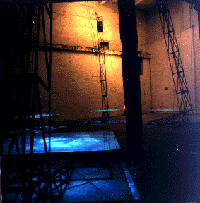| TransVisionen |
1/12 - 2/4/1996
|
|
 |
The Mind Machine of Dr. Forsythe | |
| Exhibition with installations from Anne Quirynen, Peter Missoten, An-Marie Lambrechts, Ana Torfs and Studio Azzurro The contents of the most works in the sphere of the new media are built on classic models. The goal of the project TransVisions was to present in an accentuated form three video installations with classic roots in ballet, music and literature. Il Combattimento di Achile e Ettore, a work from Studio Azzurro, is based on the on the struggle between Achilles and Hektor that was taken out of Homer's Ilias. This idea was converted into a 2 channel video installation with two monitors. The separation into two segments made it possible to increase the presentation level. Studio Azzuro and its authors has been one of the pillars of Italian video art since the beginning of the 80's. Fabrizio Plessi established his international art carrier in Studio Azzurro. Many well-known authors, such as the Berlin sound artist and dokumenta participant Christina Kubisch and the Japanese multimedia group 'dump type', enrich Studio Azzuro's culturally varied productivity. The unwanted similarity in titles to Ana Torfs' Il Combattimento di Tancredi et Clorinda emphasizes the conceptual line of this exhibit. The installation is a 3 channel video projection. The video channels were controlled synchronously, and similarly to a triptych showed different picture sequences. The pictures were projected on a large brazened wood surface. On each side of the protagonist/singer, Tancredi and Clorinda, the title figures, were displayed in profile. Torquato Tasso told the tale of the joys and sorrows of this pair in Madrigal verses. Ana Torfs is one of the up and coming young artists in Belgium. After her art studies she successfully participated in different contests and television programs. The most room-filling work of this exhibition was Dr. Forsythe's Mind Machine. Anne Quirynen, Peter Missoten and An-Marie Lambrechts worked together with the support of William Forsythe, the head of the Frankfurt Ballet, to create this quiet and yet impressive sound and projection installation. The 8 channel video installation connected a steel construction to what appeared to be floating projection surfaces made of panes of opal. From a distance visitors perceived differents sounds and noises from small speakers and the bright lines of the glass edges. Upon coming closer the projections came into view. Looking into the sculpture was like staring into ice blocks that have been broken, thawed and then refrozen. Within these blocks, dancers gave the effect of organisms trapped in ice. Their assignment was to slowly leave prints from sliding, creeping, chafing, straightening up, rolling and wiping, and then to continually draw over them. In this way a thick net of tracks and drawings was developed. The authors of this installation are part of the new generation of artists in Belgium that uses the contrasts between the new media and classic forms in the realization of their works. Contributing to the mood of the exhibition were readings and the presentation of a CD-Rom that documented William Forsythes work with the Frankfurt Ballet Ensemble. |
||